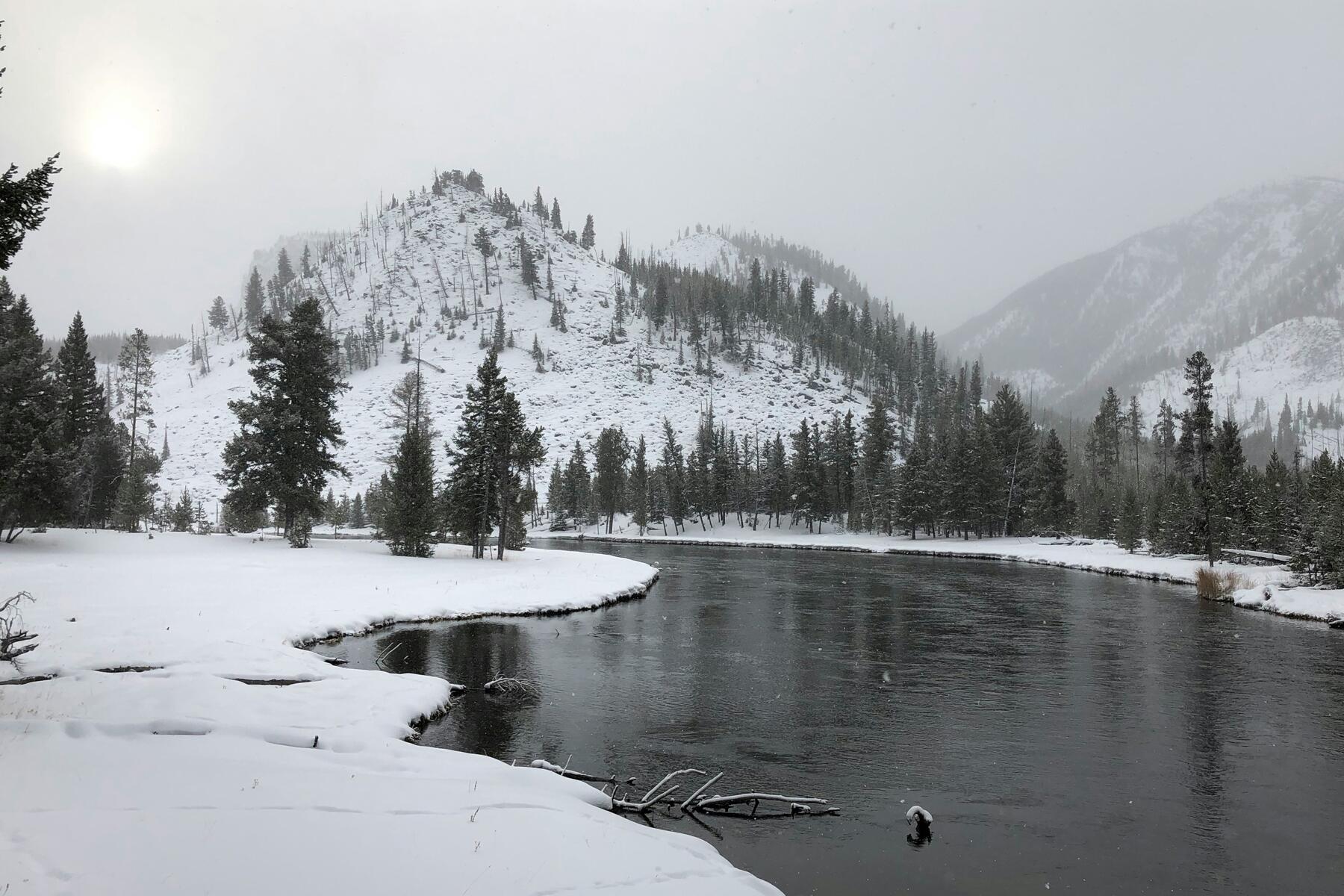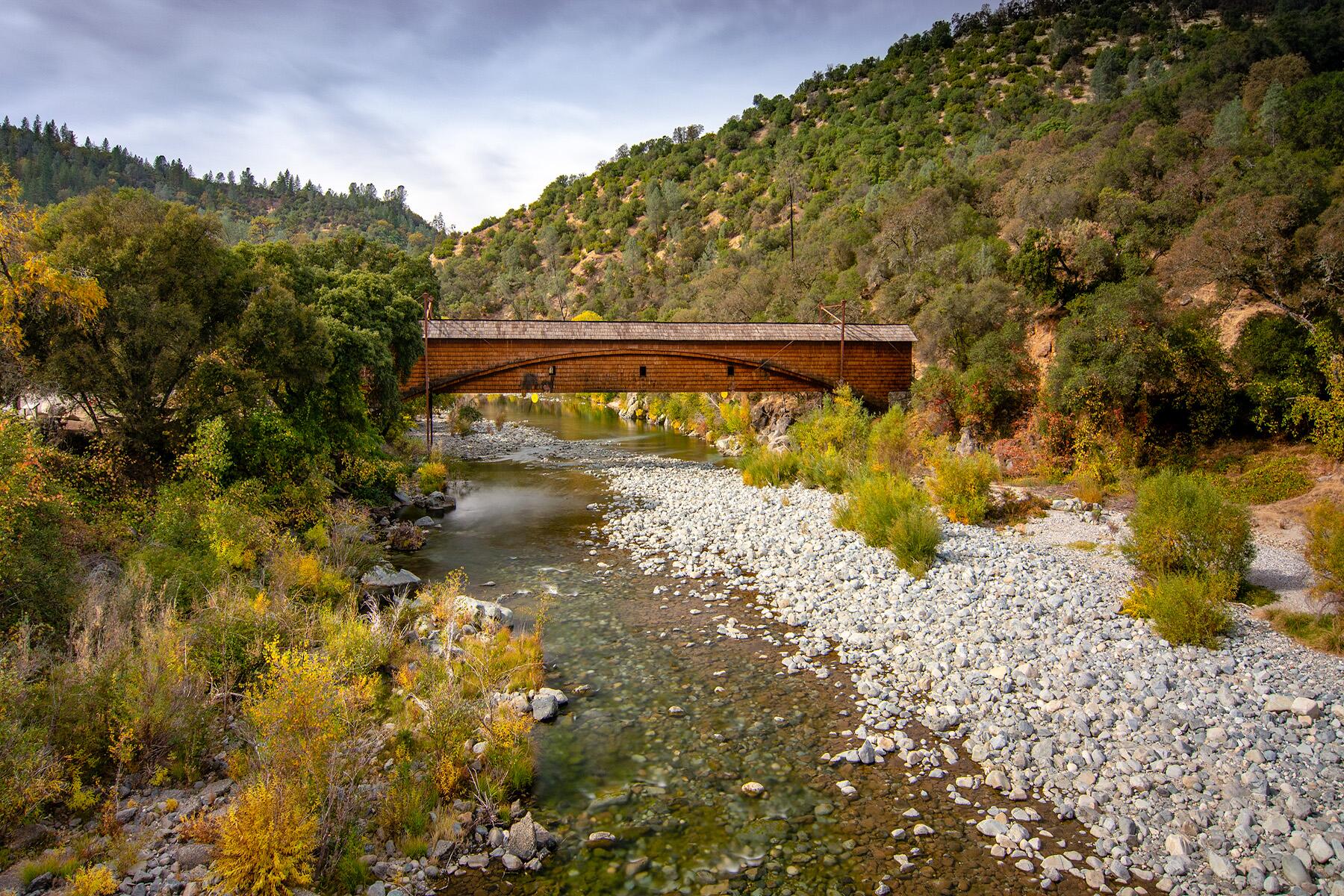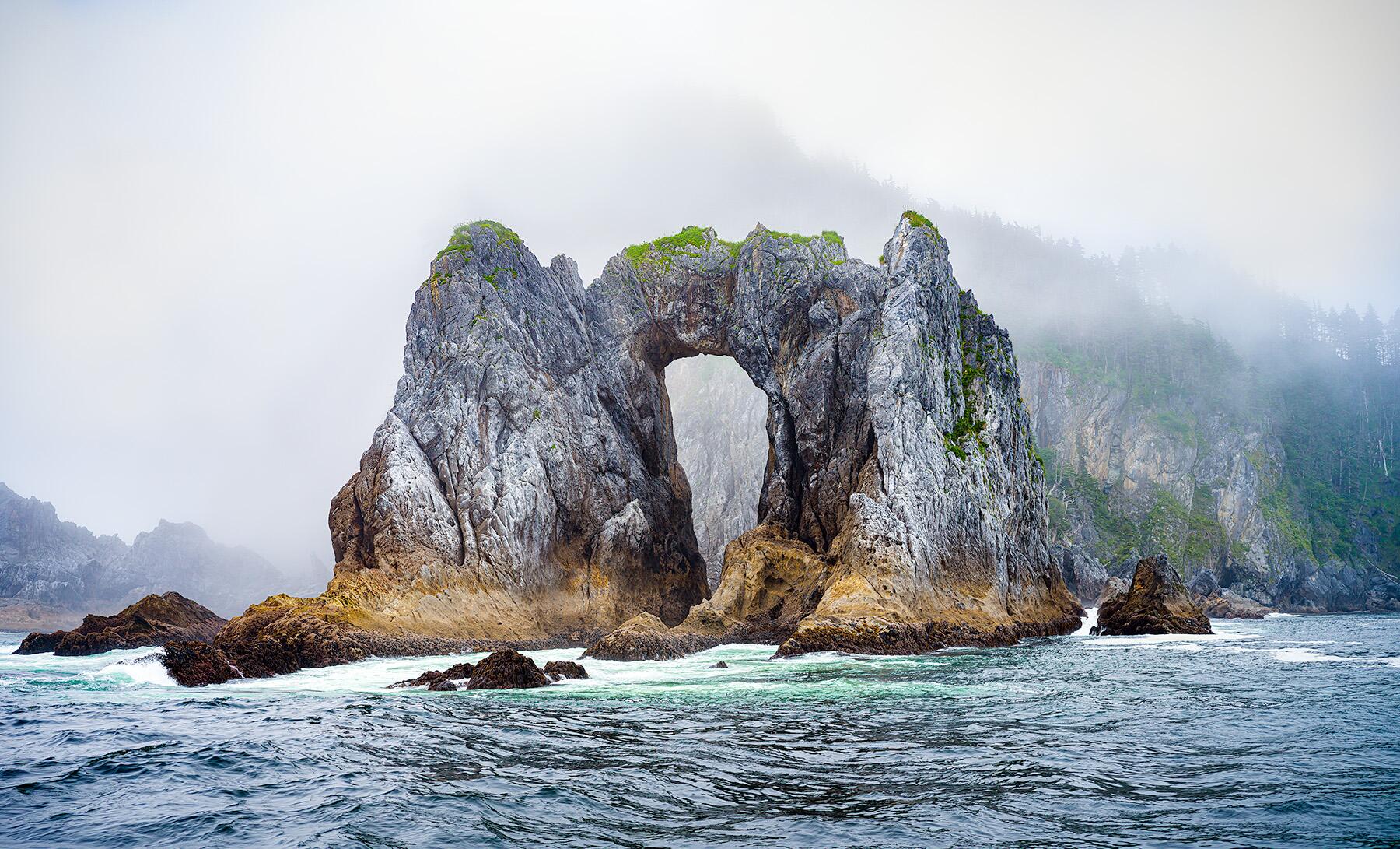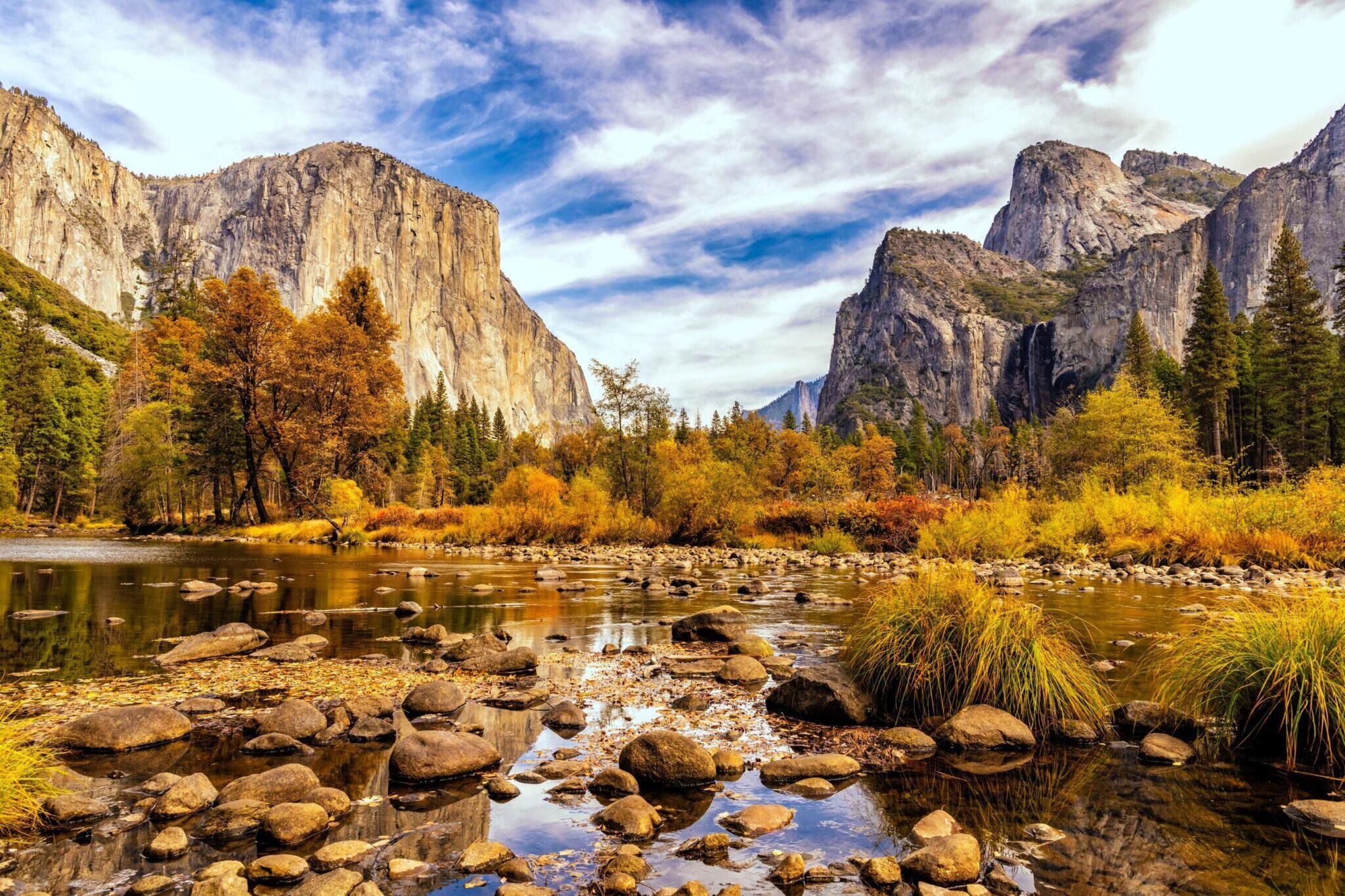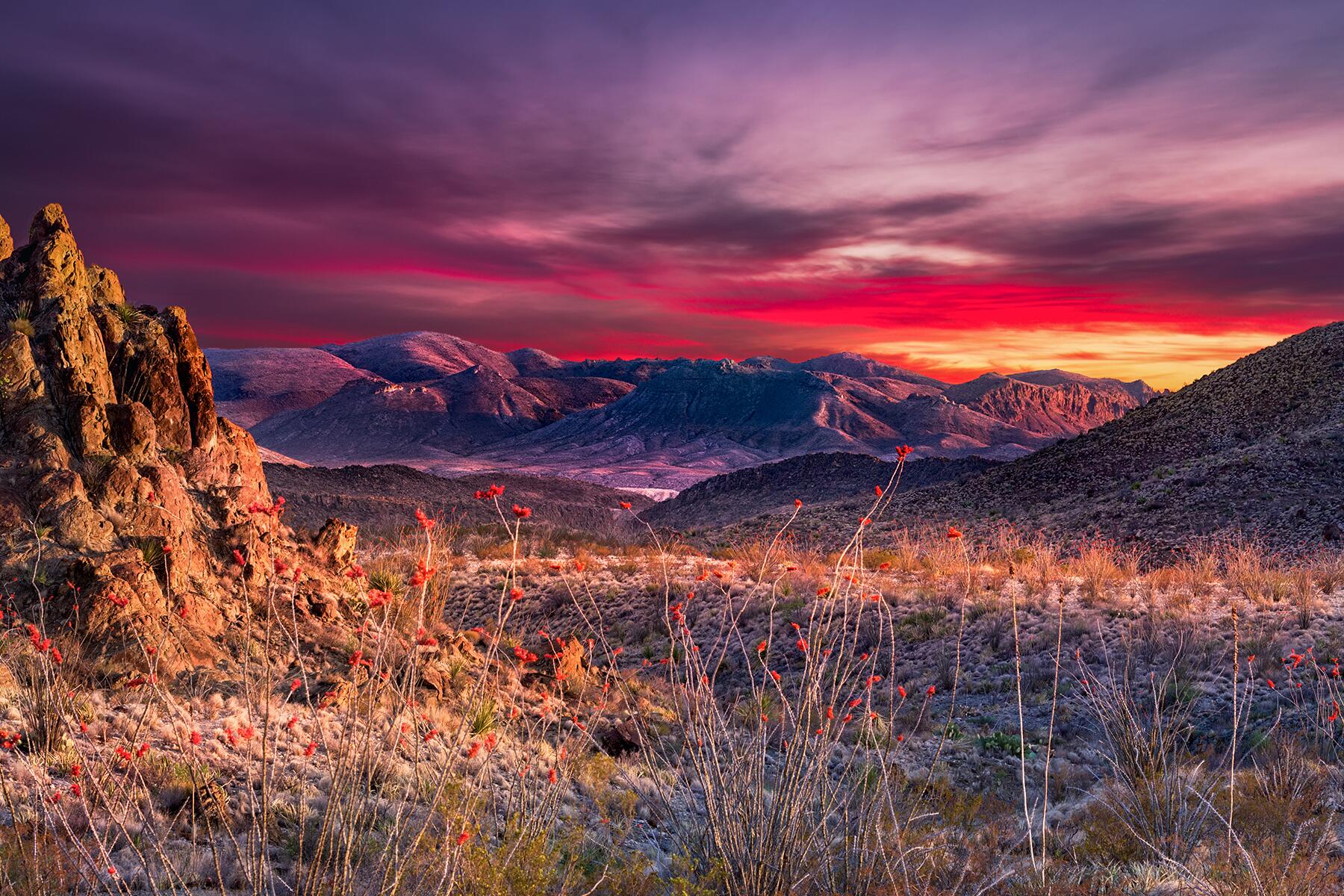From where to sleep, where to hike, and how to ride into Mexico on horseback (really!), this guide has everything you need to know about Big Bend.
Big Bend National Park is one of the last remaining wild corners of the United States, filled with incredible natural landscapes. The craggy peaks sheltering lush pine forests, steep canyons, and the impossibly vast Chihuahuan Desert are some of the starkest, most fascinating landforms on earth. It’s easy to feel like you’re on the edge of the world here, as you hike through 800,000 acres of intense, undeveloped natural beauty and sleep under those famously wide-open West Texas skies. Big Bend’s untamed glory must be seen to be believed. Due to the park’s size, though, it can be tough to learn how to navigate your way around—which is why this guide will come in mighty handy when you’re preparing for your trip.
How Do I Get There?
Big Bend is one of the least-visited national parks in the country (with just over 300,000 visitors per year) for a reason: It’s the definition of remote. Located in the southwestern corner of Texas, this sparsely-populated, wild patch of land on the U.S.-Mexico border is a considerable distance from cities and transportation hubs. The park is four hours by car from each of the nearest international airports, in Midland and El Paso (rental cars are available at both). Several highways lead to the park: FM 170 from Presidio to Study Butte, TX 118 from Alpine to Study Butte, or US 90 or US 385 to Marathon. Greyhound provides daily service to Alpine, which is around 100 miles from park headquarters; this is the site of the nearest Amtrak station, as well. No, it’s not easy to get to Big Bend, but the journey there is half the fun.
Just How Big Is Big Bend?
Big Bend National Park is comprised of 1,252 square miles of land, including the largest protected area of the Chihuahuan Desert in the U.S. Apart from the desert, visitors will experience rugged, mountainous terrain (the highest peak in the park is 7,825-foot Emory Peak, in the Chisos Mountains), dramatic rock formations, deep canyons carved by the Rio Grande, and dense forests of oak, juniper, and piñon pine. Keep in mind that there’s a lot of space between destinations, so you’ll want to leave ample time to explore everything.
Big Bend is incredibly isolated—the two main northern entrances of the park are both an hour’s drive from any towns, and the nearest major city is El Paso, which is 300 miles away. There are five visitor centers scattered around the park, although the Panther Junction and Chisos Basin centers are the only ones open year-round. If you need to secure river-use or backcountry permits, fill up with water, or simply get the lay of the land when you first arrive, Panther Junction is the place to do it.
INSIDER TIPDownload a National Park Map before you go; this is a fantastic way to get acquainted with the park’s size and layout (which takes some getting used to!).
Recommended Fodor’s Video
What's the Geological History of the Park?
Some of the rocks in Big Bend are said to be 500 million years old if that gives you any indication of the eons of time encapsulated in the park. The landscape here has borne witness to everything from desert plateaus to deep seas. For a period of at least 200 million years, a deep-ocean trough covered the entire region, and during the Cretaceous Period, a warm, shallow sea invaded the area—the sea eventually retreated and evaporated, leaving behind the limestone layers that comprise the dramatic, ancient canyons we admire today. The looming Chisos Mountains Range, formed by volcanic activity from about 35 million years ago, is the park’s centerpiece.
How Much Is the Entrance Fee?
Park entrance fees are $30 per vehicle or $15 per individual; fees and passes can be purchased at visitor centers or entrance stations. A Big Bend Annual Pass costs $55 and covers all entrance fees to the park for one year.
What Are the Best Hikes in the Park?
This all depends on the type of experience you’re craving. In Big Bend, there are giant swaths of land that are accessible for day hikes and backpacking, with over 150 miles of trails and an epic variety of scenic vistas, lunar-like landscapes, and diverse plant and animal life. In short, there’s a little something for everyone. If you’re up for a physically strenuous adventure, the 14.5-mile South Rim is the best view in Texas—an ocean of peaks jutting up from the earth’s floor, stretching well into Mexico. A shorter version of this hike would be the 4.8-mile Lost Mine Trail, which affords similar views, but nothing compares to the glory of the South Rim. Other notable trails (that are on the shorter side) include the 5.6-mile Window Loop Trail, the 3.8-mile Mule Ears Spring Trail, and the six-mile Hot Springs Canyon Trail. For the serious hiker who wants to backpack through the park, the 30-mile Outer Mountain Loop is an outstanding way to experience Big Bend. Backpacking permits are required, and water must be cached in storage boxes along the trail beforehand; this trail isn’t for the faint of heart.
Where Do I Spend the Night and How Long in Advance Should I Reserve?
The National Park Service operates three developed campgrounds that have restroom facilities and drinking water: Cottonwood, Rio Grande Village, and Chisos Basin. Limited campsites are reservable at Rio Grande Village from November 15-April 15, and at the Chisos Basin campground from November 15-May 31; otherwise, reservations aren’t taken, and campsites are first-come, first served. In addition, a full hookup RV camping area, the Rio Grande Village RV Campground, is operated by the park concessioner, Forever Resorts. Apart from that, there are primitive roadside campsites and backpacking sites available, though you’ll need to obtain a permit at Panther Junction to secure one of these sites. The National Park Service also has a list of camping options outside the park.
Don’t feel like roughing it? Book a stay at the Chisos Mountains Lodge—just note that reservations do tend to fill up fast, as this is the only lodge in the park. No matter what time of year you’ll be visiting, plan to book your room at least six months in advance. If you can’t get a spot at the lodge, nearby towns Terlingua, Marfa, Marathon, Lajitas, and Study Butte all offer a range of accommodation types, from camping to glamping and rustic motels to luxury resorts.
INSIDER TIPBig Bend is busiest during any extended weekends related to federal holidays—Thanksgiving, Christmas, and New Years are the big ones—and over spring break (mid- to late March). Visitors can expect all of the park’s three frontcountry campgrounds (Chisos Basin, Rio Grande Village, and Cottonwood) to fill each day, so be sure to make backup lodging plans—or better yet, plan your visit around these holidays.
Are There Showers and Bathrooms in the Park?
The park’s three official campgrounds—Chisos Basin, Cottonwood, and Rio Grande Village—all have restroom facilities. However, the only showers in Big Bend are located at the Rio Grande Village Store, where the pay-to-use showers are available 24/7.
What Supplies Should I Bring With Me and Is There Food and Water Available?
The park has four camp stores, and there are some small stores in the communities outside the park, but supply and selection can be limited—it’s best to come prepared. Pack your strongest sunblock, more water than you think you’ll need (one gallon per person per day is recommended, but you may need more if you’re doing a big hike), breathable, sun-protective clothing, plenty of food, comfy hiking shoes, and any camping and hiking equipment you need. If you’re going in winter, a well-insulated sleeping bag and plenty of base layers are a must. Oh, and don’t forget your passport if you plan on crossing the border.
Where Can I Fill up on Gas?
Gas stations are few and far between in this part of the world, so it’s important to know in advance where you can fill up—or risk running out of gas in the middle of nowhere. In the park, Panther Junction and Rio Grande Village both have service stations with gas and diesel. Outside the park, the closest stations are in Study Butte (Big Bend Resorts and Adventures), Lajitas (the Lajitas General Store), Terlingua (Terlingua Auto Service), and FM 2627 (Stillwell Store, just north of the park).
When Should I Plan to Visit the Park and What Will the Weather Be Like?
Avoid the park altogether during spring break (mid- to late March), Thanksgiving, and the holiday break in December, if at all possible—the crowds will only cramp your style, and it can be tough to find accommodations. Spring and fall are the best time of year to visit; the weather is mild and sunny. Otherwise, summers are brutally, often dangerously, hot and it occasionally snows (and gets very cold!) in January and February.
Regardless of the season, keep in mind that weather in Big Bend can change on a dime, especially when you factor in elevation changes. Temperatures at the lowest reaches near the Rio Grande can sometimes average over 20 degrees warmer than up in the Chisos Mountains.
INSIDER TIPWhile it’s true that Big Bend is breathtaking in every state—snow, sun, rain—there’s something special about seeing the park covered with thick carpets of rainbow-colored wildflowers. During the springtime (late February through late April), visitors can spot giant bluebonnets, yuccas sprouting wispy white blooms, bright purple Texas mountain laurel, and ocotillo ablaze with fiery red flowers, among many other flowering plants. It’s a majestic sight.
What Should I Know About Visiting With Kids?
Kids and parents alike will love taking easy-yet-rewarding hikes in Big Bend, like the Window View and Basin Loop trails in Chisos Basin, the Boquillas Canyon Trail, and the Rio Grande Village Nature Trail. Those with older kiddos should plan to hike the Lost Mine Trail, a gorgeous trail that serves as the perfect introduction into the flora and fauna of the Chisos Mountains. The park also offers a variety of interactive, ranger-led programs, including bird walks, guided hikes, and more; stop by one of the visitor centers for a current program schedule.
How Can I Access the Border Crossing Into Mexico?
Visiting Mexico through the park’s Boquillas Crossing Port of Entry is an option for visitors who possess a valid U.S. passport—after passing through the Port of Entry, visitors are ferried across the Rio Grande on a rowboat for a small fee; walking is permitted but not recommended if the water level is high (and hey, when else will you get the opportunity to cross over into Mexico via rowboat?) Once you’re across the river, you’ll be required to check in with Mexican immigration officials upon arrival into the village, Boquillas del Carmen, the charming, colorful remains of a former mining town.
INSIDER TIPGet a seat up on the deck at Jose Falcon’s, one of two restaurants in town, where you can chow down on delicious tacos and sip margaritas while you enjoy the stunning views of the river and the park—after making the long trek here, you’ve earned it.
Will My Cell Phone Work in the Park?
Now’s the time to embrace tech-free solitude, being off Twitter, and the lack of group text notifications coming in, because cell service in Big Bend is spotty at best, and some carriers don’t even come close. If you do need to use your phone, your best bet is to head to the Chisos Basin area or Panther Junction.
What and Where Are the Hot Springs?
The Boquillas Hot Springs—a 105-degree pool contained by the remnants of an early 1900s bathhouse—are pressed up directly against the rushing Rio Grande. You can soak your tired hiker body in the springs while dangling an arm over the rock wall into the icy river waters. To get there, take the two-mile Hot Springs Road down to the trailhead area (note that motor homes and oversize vehicles aren’t allowed on the one-way sections of this narrow road) and walk the half-mile to the springs.
INSIDER TIPChange into your swimming attire before you go; there are no changing rooms at the springs, just a small toilet that’s seen better days.
Can I Swim in the Rio Grande?
Flowing through Big Bend National Park and the adjacent U.S. Wild and Scenic River, the mighty Rio Grande traverses five major canyons and serves as the international boundary between Mexico and the U.S. in the park. While swimming isn’t recommended, floating the Rio Grande is the perfect way to experience the wonder of this region. Canoes, rafts, and kayaks are allowed on the river; you can either bring your own equipment or you can hire a guide service (For a full list of local outfitters who provide shuttles, guided trips, and equipment rental, see the NPS recommendations here.).
What Else Is There to Do Besides Hike?
Big Bend’s grandeur attracts all kinds, not just hardcore hikers. Birders will rejoice in identifying the 400+ species that reside here, photographers will love attempting to capture the park’s splendor in a photo (it can’t be done, but you can certainly try!), and astronomy buffs can nerd out over the night skies—Big Bend is one of the darkest places in the lower 48. Don’t miss the hot springs and crossing over into Boquillas del Carmen, the nearby Mexican village. And for some educational fun, check out the park’s newest exhibit, the Fossil Discovery Exhibit, where visitors can immerse themselves in the changes to Big Bend’s plants and animals and the world they lived in, through 130 million years of geologic time.
But if you’re not into hiking and you still want to experience what Big Bend has to offer, the best thing to do is cruise along the Ross Maxwell Scenic Drive, which offers fabulous views of the desert landscape and will lead you to the Rio Grande. There are plenty of scenic overlooks and exhibits along the way, but the true highlight of the drive is the short walk to Santa Elena Canyon—few sights rival the view upstream into this glorious, 1,500-foot gorge, an especially impressive view at sunset.
What Kinds of Wildlife Will I See?
Javelinas, coyotes, and bears, oh my! Big Bend is home to a variety of rich, diverse wildlife, including black bears, fox, skunks, mule deer, jackrabbits, rattlesnakes, mountain lions, javelinas, and more documented bird species than in any other national park. All in all, the park contains 75 species of mammals, 450 species of birds, 11 species of amphibians, 56 species of reptiles, and 40 species of fish, not to mention 1,200 species of plants.
When dealing with wildlife, certain safety precautions are necessary. Be sure to store all your food, coolers, and cooking utensils in your car, and use available food storage lockers at campsites. And most importantly, don’t be the person who feeds a Cliff bar to a javelina at your campsite—for both your safety and the animal’s, feeding wildlife is an absolute NO.
Can I Bring My Pet(s)?
Pets aren’t allowed on trails, off roads, or on the river in Big Bend National Park. Your pet can only go where your car can go; qualified service animals assisting those with disabilities are allowed throughout the park and in all park facilities, but they must be leashed. In short, technically, you can bring your pet…but it’s probably best to leave your fur baby at home if you want to hike, explore, and fully experience the park.
